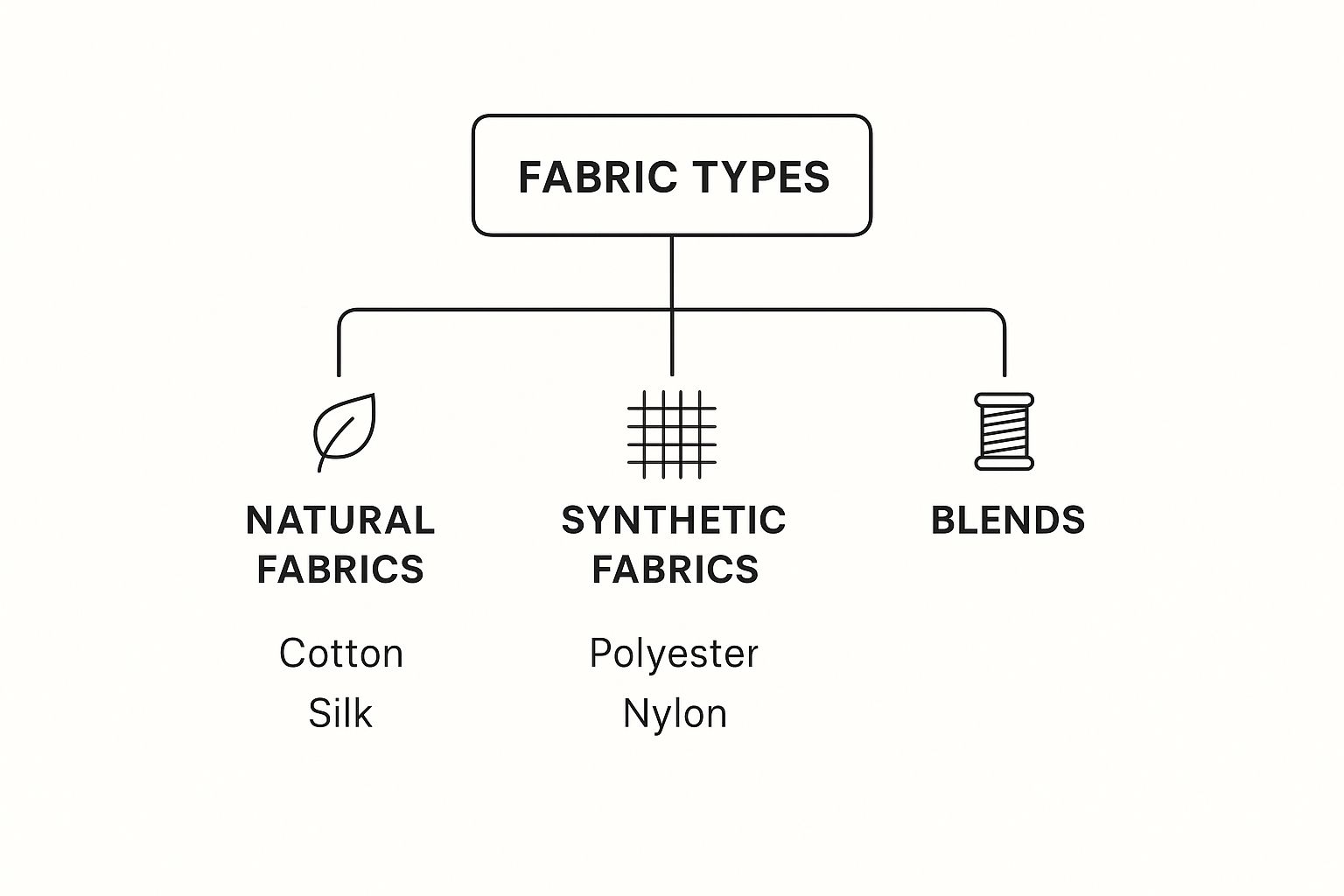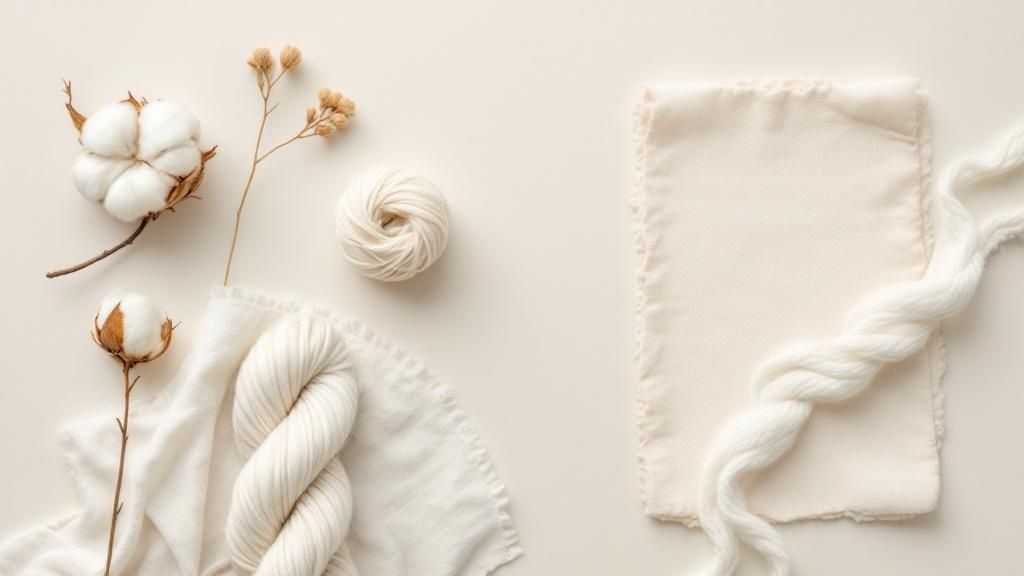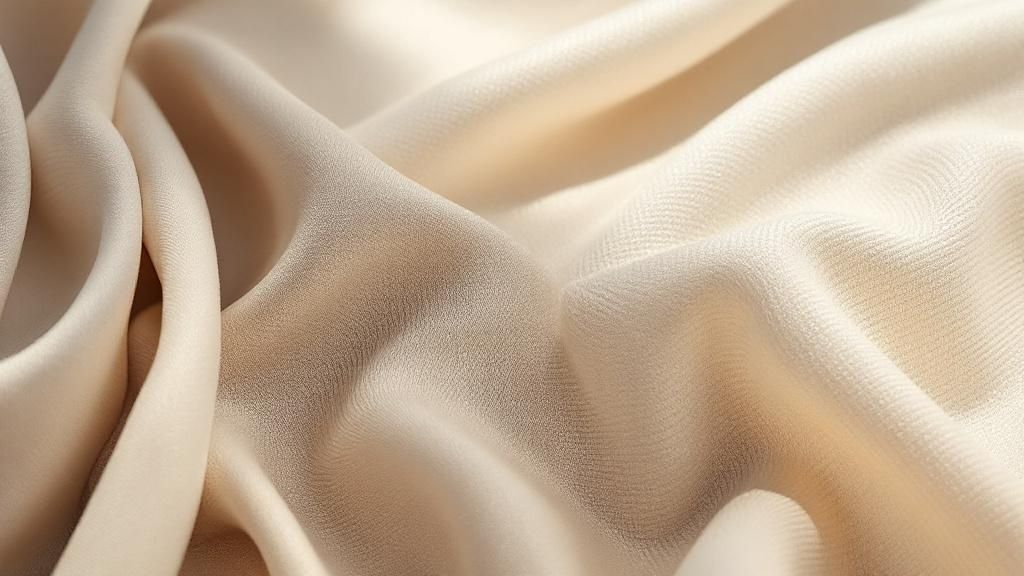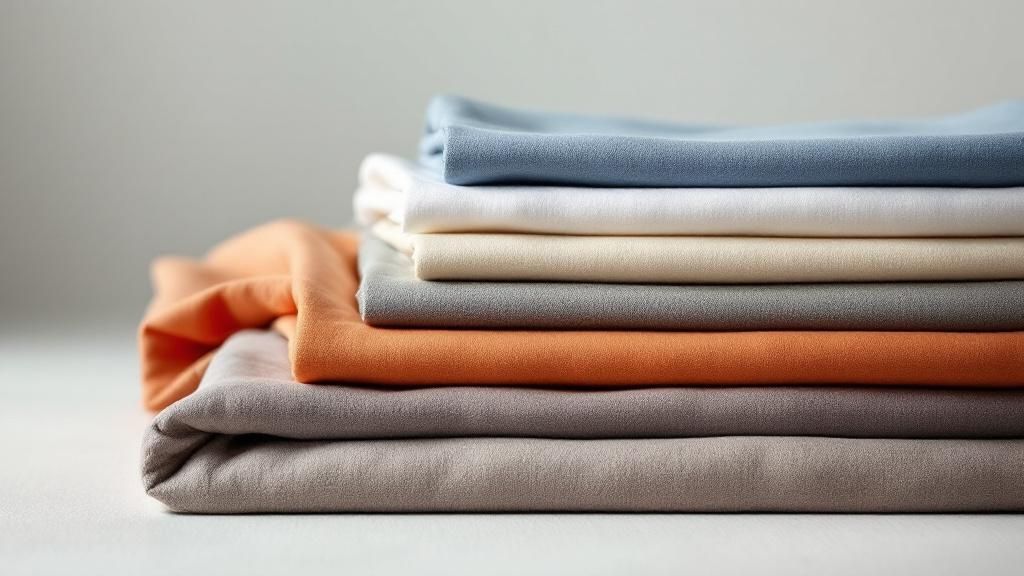Choosing the right clothing goes far beyond just picking a style or color you like. The real secret to comfort, durability, and how a garment actually functions lies in its fabric. The material of your clothes is what dictates whether you feel cool on a sweltering day, if your shirt emerges from a suitcase hopelessly wrinkled, and how long your favorite pieces will actually last.
Why The Fabric of Your Clothes Matters
Have you ever wondered why your gym shirt feels so different from your work blouse? Or why a breezy linen suit is a summer go-to, while a wool coat is your best friend in winter? The answer is all about understanding the different types of fabrics used for clothing. It’s a bit like a chef knowing precisely when to use olive oil versus butter—each one creates a completely different result.
Learning about fabrics turns you from a regular shopper into a savvy one. You stop just buying a "nice shirt" and start selecting a garment for its specific qualities. This isn't just a fun fact; it's a practical skill for building a classic wardrobe that truly works for you. It gives you the power to choose pieces that not only look good but feel incredible and perform exactly how you need them to.
The textile industry is absolutely massive, which shows just how vital these materials are in our day-to-day lives. In 2023, the global textile market was valued at an astonishing USD 1,837.27 billion. Natural fibers alone made up over 44% of that value, thanks to how widely they're used in the clothes we wear every day.
The Three Core Fabric Families
At its heart, every single piece of clothing you own is made from one of three main categories of fabric. It’s a simple but powerful way to start understanding your closet.

As you can see, textiles are grouped into families based on where they come from, and that source directly shapes their personality and performance.
To give you a quick overview, here's a simple breakdown of these fabric families.
Fabric Families at a Glance
This table provides a snapshot of the three main fabric categories, their origins, and their core characteristics.
| Fabric Category | Source | Key Properties |
|---|---|---|
| Natural | Plants (cotton, linen) or Animals (wool, silk) | Breathable, soft, comfortable, often hypoallergenic |
| Synthetic | Man-made chemical processes (polyester, nylon) | Durable, wrinkle-resistant, moisture-wicking, stretchy |
| Blended | A mix of natural and synthetic fibers | Combines benefits of both, e.g., soft yet durable |
Having this basic framework in mind is the first step toward making smarter choices when you shop.
Here’s a closer look at what defines each family:
- Natural Fabrics: These are fibers derived straight from plants (like cotton and linen) or animals (like wool and silk). They're celebrated for their incredible breathability and next-to-skin comfort.
- Synthetic Fabrics: These are man-made fibers created through chemical engineering (think polyester and nylon). Their strengths lie in durability, impressive stretch, and moisture-wicking abilities.
- Blended Fabrics: These are the hybrids. They cleverly combine fibers from the other two groups to get the best of both worlds, like pairing the softness of cotton with the wrinkle-resistance of polyester.
Choosing the right fabric is the foundation of both personal style and genuine comfort. It’s the difference between a garment you simply wear and one you truly love to live in.
Grasping these fundamental groups is your first step toward becoming a more discerning shopper. Once you can identify the fabric family, you can instantly predict how a garment will likely feel, perform, and need to be cared for. This guide will walk you through each of these types, giving you the confidence to select the perfect fabric for any occasion.
Exploring Breathable Natural Fabrics

Diving into the world of natural fabrics is like stepping into a garden of textures and sensations. These are the materials that come straight from the earth—sourced from plants and animals—and they have a unique connection to our skin. They’re the original textiles, valued for centuries not just for how they look, but for their incredible comfort and breathability.
Unlike their synthetic, lab-created cousins, natural fibers have a certain "life" to them. They breathe and interact with our bodies in a way that’s almost impossible to replicate. Let’s get to know the personalities of the most prominent members of this fabric family.
Cotton The Approachable Classic
If natural fabrics were a family, cotton would be the friendly, reliable sibling everyone loves. It's the most widely used natural fiber for a very good reason—it’s soft, incredibly versatile, and feels great against the skin. Just think of your favorite, perfectly worn-in t-shirt; odds are, it's made of cotton.
Its fibers are naturally porous, which means air can circulate freely. This makes cotton exceptionally breathable, keeping you cool and comfortable in most weather. It's also a champ at absorption, which can be both a pro and a con. It pulls moisture away from your skin, but once it's saturated, it can get heavy and take its sweet time to dry.
The sheer economic scale of this fiber is mind-boggling. The global textile market was valued at USD 507.63 billion in 2023 and is on track to hit around USD 882.71 billion by 2032. In this massive market, cotton is a consistent heavyweight, thanks to its endless uses in clothing and home goods. You can dig into more data on the global textile fabrics market on Zion Market Research.
Ideal For:
- Everyday Essentials: T-shirts, underwear, casual button-downs, and classic denim jeans.
- Bedding and Towels: Its softness and absorbency are perfect for linens and towels that live right next to your skin.
Care Tips: Cotton is generally low-maintenance, but it can shrink in hot water or a hot dryer. Your best bet is to wash in cool or warm water and tumble dry on low.
Linen The Natural Air Conditioner
Linen is that effortlessly chic cousin who spends their summers on the coast. It’s spun from the tough fibers of the flax plant and is one of the oldest textiles known to humanity. Its signature trait is a crisp, textured feel that, believe it or not, gets softer and more wonderful with every single wash.
What really makes linen special is how unbelievably cool it is to wear. The flax fibers are hollow, allowing for maximum airflow—it genuinely feels like a personal air conditioning system on a scorching day. It can also absorb a ton of moisture without feeling damp and dries way faster than cotton.
Linen's tendency to wrinkle isn't a flaw; it's part of its charm. Those characteristic crinkles give the fabric a relaxed, lived-in elegance that is highly sought after in sophisticated resort and summer wear.
This fabric is your best friend when the heat and humidity are dialed up to eleven.
- Summer Wardrobe Staples: Breezy trousers, relaxed shirts, elegant dresses, and lightweight blazers.
- Warm-Weather Suiting: Gives you a sharp silhouette without the stuffiness of heavier wools.
Care Tips: Linen loves a good wash and just gets better with age. Use a gentle cycle with cool water to protect the fibers. You can tumble dry on low, but hanging it to dry will keep wrinkles to a minimum. My advice? Embrace the crinkles, but if you must iron, do it while the fabric is still a little damp.
Silk The Ultimate Luxury
Silk is pure, unadulterated opulence. Spun by silkworms, its fibers are treasured for their incredible strength, softness, and luminous sheen. Wearing silk is a full-sensory experience; it glides and drapes over the body with a smooth, cool-to-the-touch feel that no other fabric can quite match.
Don't let its delicate appearance fool you—silk is a surprisingly strong natural fiber. It's also a brilliant temperature regulator. The unique proteins in its fibers help it feel cool in the summer and warm in the winter, making it a surprisingly versatile choice for year-round luxury.
Ideal For:
- Formal and Evening Wear: Think gowns, blouses, and neckties where its beautiful drape and luster can truly shine.
- Luxury Loungewear: Robes and pajamas that feel absolutely indulgent against the skin.
- Delicate Accessories: Scarves and pocket squares that add a perfect touch of refinement.
Care Tips: Silk demands a gentle hand. Hand washing in cool water with a mild detergent is the safest route. Never wring it out. Instead, gently roll it in a clean towel to blot out excess water, then hang it to dry away from direct sunlight, which can weaken the fibers.
Wool The Master Insulator
Wool often gets typecast as the star of bulky winter sweaters, but it’s a far more versatile fiber than it gets credit for. Sourced from the fleece of sheep, its fibers are naturally crimped. This creates thousands of tiny air pockets, which is the secret to its incredible insulating power. These pockets trap air, keeping you warm when it's cold and, surprisingly, cool when it's hot.
This natural wonder can absorb up to 30% of its own weight in moisture before it even starts to feel damp, wicking sweat away from the skin to keep you dry and comfortable. It’s also naturally elastic, odor-resistant, and flame-retardant. From chunky cable-knits to the fine-gauge merino wool used in high-performance activewear, its range is truly impressive.
Ideal For:
- Outerwear and Suiting: Coats, jackets, and trousers that need warmth and structure.
- Knitwear: Sweaters, cardigans, and base layers for any season.
- Performance Wear: Merino wool is a favorite for hiking socks and athletic gear because of its moisture-wicking and anti-odor magic.
Care Tips: Many wool pieces are dry-clean only, so always check the label. If you can wash it, use cold water and a wool-specific detergent. Always, always lay wool flat to dry to prevent it from stretching out of shape.
Understanding Engineered Synthetic Fabrics

While natural fabrics bring the charm of the earth to our wardrobes, synthetic fabrics deliver the raw power of the laboratory. It's a mistake to think of them as just "cheap" alternatives. These are high-performance materials, engineered with a specific job in mind.
Think of them as specialized tools built to solve problems natural fibers can't always handle—like providing incredible stretch or refusing to wrinkle after being crammed in a suitcase for hours.
Born from chemical processes, often using petroleum-based sources, synthetic fabrics have a unique set of superpowers. They’re known for exceptional durability, resistance to pests like moths, and an uncanny ability to hold vibrant color without fading.
Let's dive into the most common engineered fabrics you'll find hanging in your closet.
Polyester: The Resilient Workhorse
If you’ve ever pulled a shirt from your luggage and worn it straight to a meeting without an iron in sight, you’ve experienced the magic of polyester. It’s the most widely used synthetic fiber on the planet, celebrated for its incredible strength, wrinkle resistance, and knack for drying in a flash.
Polyester fibers are hydrophobic, a fancy way of saying they repel water instead of absorbing it. This is precisely why it dominates the world of activewear. While a cotton tee gets soaked and heavy with sweat, polyester pushes that moisture to the fabric's surface where it can evaporate, keeping you dry and comfortable.
For anyone with an active lifestyle, knowing how these fabrics work is a game-changer. For instance, understanding the benefits of moisture-wicking workout clothes can completely elevate your fitness experience.
Ideal For:
- Activewear: Leggings, sports tops, and jackets that need to manage sweat and handle intense activity.
- Outerwear: Coats and windbreakers that demand durability and water resistance.
- Travel and Work Attire: Blouses, trousers, and suiting that resist wrinkles and hold their shape all day.
Care Tips: Polyester is tough. You can machine-wash it in warm water and tumble-dry on low. Just be careful with high heat—it can permanently damage or even melt the fibers, so keep that iron on a low setting.
Nylon: The Durable Pioneer
Nylon was the world's first commercially successful synthetic fiber, first hitting the scene as a revolutionary replacement for silk stockings. Today, its legacy is built on something else entirely: its remarkable strength, elasticity, and incredible resistance to abrasion. It’s seriously tough for its weight, making it the go-to for items that endure a ton of wear and tear.
Like polyester, nylon is also hydrophobic and dries quickly. Its smooth, silky texture makes it a popular choice for everything from delicate lingerie to rugged outerwear. It's the silent hero behind parachutes, ropes, and the durable jackets that shield you from the elements.
Nylon's unique combination of lightweight strength and a smooth feel makes it a versatile problem-solver in fashion. It can create both delicate, sheer garments and incredibly rugged, long-lasting gear.
This incredible adaptability is what has kept nylon a wardrobe staple for nearly a century.
- Outerwear: Parkas, bomber jackets, and windbreakers rely on its durability and weather resistance.
- Hosiery and Lingerie: Its fine, smooth filaments create sheer yet strong fabrics.
- Active and Swimwear: Its strength and quick-dry properties are perfect for performance-focused apparel.
Care Tips: Nylon is generally fine in a cold or warm machine wash. It's best to tumble dry on a low heat setting, as high temperatures can cause it to shrink or melt.
Spandex: The Stretch Specialist
Spandex, which you might know by brand names like Lycra or elastane, is the fabric that gives our clothes their amazing stretch and recovery. You’ll never find it used on its own; instead, small amounts are blended with other fibers (like cotton or polyester) to add comfort, movement, and shape retention. Think of it as a magic ingredient.
A fabric needs as little as 2% spandex to gain significant stretch. This is what allows your favorite skinny jeans to hug your curves without feeling like a straightjacket and lets your athletic wear move with you like a second skin. Its ability to stretch to many times its original size and snap right back is what stops your clothes from bagging out at the knees and elbows.
Ideal For:
- Athleisure and Activewear: Almost all modern sportswear contains spandex for maximum mobility.
- Form-Fitting Garments: Skinny jeans, bodycon dresses, and fitted tops depend on it for their silhouette.
- Swimwear: Provides the essential stretch for a snug, comfortable fit that stays put.
Care Tips: To keep its springiness, wash spandex blends in cool water and steer clear of the high heat of the dryer—air drying is always your best bet. Fabric softeners can also clog its fibers and reduce their ability to manage moisture, so it's best to skip them, especially for your activewear.
How Blended Fabrics Give You the Best of Both

Ever wished for a t-shirt with the cloud-like softness of cotton but the wrinkle-resistance of polyester? Or maybe work trousers that are tough enough for the daily grind but still feel comfortable and breathable? This isn't about compromise; it's the brilliant science behind blended fabrics.
Think of it like building a dream team. Textile engineers intentionally combine different fibers—both natural and synthetic—to create a brand-new material. The goal is to cherry-pick the best qualities from each "parent" fiber, resulting in a superior hybrid. It’s a process designed to solve specific problems and boost performance, making blends one of the most practical and innovative fabric types for clothes today.
By weaving different threads together, manufacturers can fine-tune a fabric’s properties from the ground up. They can dial up the durability, improve the texture, and enhance the overall look, all while making the final garment easier to care for and more affordable.
The Power of Poly-Cotton
One of the most common—and frankly, most useful—blends you'll come across is poly-cotton. As the name suggests, it's a mix of polyester and cotton, and it’s a true workhorse in the apparel world. It strikes that perfect balance between comfort and pure convenience.
Pure cotton is wonderfully soft and breathable, but let's be honest, it wrinkles if you so much as look at it funny and takes ages to dry. On the other hand, 100% polyester is incredibly durable and wrinkle-proof, but it can sometimes lack that soft, natural feel we all love. When you blend them, you get a fabric that truly delivers.
A poly-cotton t-shirt, for example, keeps a great deal of cotton's signature softness but gains polyester's resilience. It holds its shape far better after washing, resists shrinking, and needs way less ironing than its 100% cotton counterpart.
Blended fabrics are not a compromise on quality; they are an enhancement. They are thoughtfully engineered textiles that offer functional solutions for everyday life, combining the best traits of different fibers to create something even better.
This specific blend is a fantastic example of practical textile innovation. It’s the perfect solution for anyone who wants low-maintenance clothing without giving up on comfort.
Finding the Perfect Functional Blend
The key to choosing the right blend is knowing what you need from your clothes. Are you looking for rugged durability for your workwear, or do you need serious stretch for activewear? Once you know the end goal, you can zero in on the perfect fabric combination.
Here are some of the most common problem-solving blends and what they bring to the table:
-
For Durable Softness (Poly-Cotton): As we covered, this is your go-to for everyday staples like t-shirts, polos, and even bed linens. You get all the comfort of cotton with the easy-care durability of polyester.
-
For Comfortable Stretch (Cotton-Spandex): Ever wonder how your favorite jeans move with you? A tiny bit of spandex (often just 2-5%) is blended with cotton to provide that crucial stretch for a perfect, comfortable fit, all while keeping that classic denim feel.
-
For Warmth Without Weight (Wool-Acrylic): Pure wool is incredibly warm but can be heavy and a bit fussy to wash. Blending it with acrylic makes knitwear much lighter, more affordable, and often machine-washable, all while keeping you nice and toasty.
-
For Silky Drape and Easy Care (Rayon-Polyester): Rayon has a gorgeous, fluid drape that feels a lot like silk, but it can be delicate and prone to wrinkling. Adding polyester makes the fabric tougher, more wrinkle-resistant, and easier to wash—perfect for elegant blouses and dresses that don't need constant babysitting.
By looking for these specific combos on the clothing label, you can shop strategically for garments that are perfectly suited to your life. This knowledge transforms you from a casual shopper into an informed consumer who understands the different fabric types for clothes and how to make them work for you.
Matching Fabrics to Your Life and Style
Understanding the properties of different fabrics is one thing, but knowing how to apply that knowledge to your actual life is where the real skill comes in. This is where theory meets the reality of your closet. After all, your wardrobe should work for you, not the other way around.
By matching fabrics to your daily activities, the climate you live in, and your personal style, you can build a collection of clothes that truly feels as good as it looks. Let's walk through how to choose the right textiles through the lens of a few common lifestyles. Think of these as personas—you'll probably see a bit of yourself in each one.
For The Office Professional
The modern professional needs a wardrobe that telegraphs confidence and competence, all while standing up to the rigors of a long day. The key is to find fabrics that offer structure, resist wrinkles, and keep you comfortable from your morning coffee to your evening commute.
You need materials that look sharp at 9 AM and still look put-together for after-work events. Wool is a fantastic choice for suiting, and not just for its warmth. It has an elegant drape and a natural resistance to wrinkling that makes a well-made wool blazer or pair of trousers a true cornerstone of any professional wardrobe.
For blouses and shirts, consider these options:
- Silk: It offers an unmatched luxurious drape that looks incredibly polished. While it requires gentle care, it's a perfect choice for a statement piece.
- High-Quality Cotton: A crisp, high-thread-count cotton shirt is a timeless classic. Look for weaves like poplin for that smooth, sharp finish.
- Rayon Blends: A blend of rayon with something like polyester can give you a silk-like feel and drape but with added durability and much easier care.
Beyond the initial choice, knowing how to maintain these pieces is crucial. For instance, once you've found that perfect wool-blend sweater, you'll want it to last. Learning how to properly care for your knit garments is a practical step that protects your investment pieces.
For The Fitness Enthusiast
When you’re pushing your body to its limits, your clothing shouldn't be what holds you back. The fitness enthusiast needs fabrics engineered for performance, prioritizing moisture management, stretch, and durability above all else. This is where synthetic fabrics truly shine.
Natural fibers like cotton are actually a poor choice for intense workouts. They absorb sweat, becoming heavy, damp, and clingy, which can lead to chafing and serious discomfort. Instead, your gym bag should be packed with performance textiles.
Your workout gear is technical equipment. Choosing the right fabric is just as important as choosing the right running shoes—it directly impacts your comfort, performance, and focus.
Look for these high-performance materials in your activewear:
- Polyester: This is the undisputed king of activewear. Polyester is hydrophobic, meaning it actively pulls moisture away from your skin to the fabric's surface where it can evaporate.
- Nylon: Known for its impressive lightweight strength and silky feel, nylon is a common feature in running shorts and windbreakers.
- Spandex (Elastane): This is the magic ingredient. It provides the incredible stretch that allows for a full range of motion, which is crucial for everything from yoga to weightlifting.
For The Weekend Adventurer
Whether you’re hiking a mountain trail, exploring a new city, or just enjoying a casual brunch, weekend wear is all about versatility and comfort. The weekend adventurer needs fabrics that can adapt to different settings and activities without a fuss.
Denim, a rugged cotton twill, is the quintessential weekend fabric for a reason—it’s durable, gets more comfortable with wear, and is effortlessly stylish. For warmer days, linen and chambray (a lightweight cotton that has a denim-like look) are excellent choices that keep you feeling cool and relaxed.
For those who love the great outdoors, layering is everything. A merino wool base layer is a fantastic investment. It’s naturally moisture-wicking, great at regulating temperature, and even odor-resistant, making it perfect for a long day of exploring that might end with a casual dinner.
Which Fabric Is Best for Your Activity?
Sometimes, seeing it all laid out makes the choice much clearer. This table compares common clothing fabrics, highlighting their ideal uses and key performance metrics to help you pick the perfect material for any situation.
| Fabric Type | Best For | Breathability | Durability | Moisture-Wicking |
|---|---|---|---|---|
| Cotton | Everyday casual wear, T-shirts | High | Medium | Low (Absorbs moisture) |
| Wool | Suiting, outerwear, base layers | High | High | High |
| Silk | Formal wear, luxury blouses | Medium | Low | Low |
| Polyester | Activewear, travel clothing | Low | High | High |
| Linen | Summer wear, resort clothing | Very High | Medium | Medium |
| Spandex Blend | Form-fitting apparel, athletic gear | Varies | Medium | Varies |
By arming yourself with this kind of knowledge, you can move beyond simply buying clothes and start strategically building a wardrobe. You can confidently pick out garments that aren't just stylish, but are perfectly suited to the demands of your unique life.
Of course. Here is the rewritten section, crafted to sound like it was written by an experienced human expert, following the provided style guide and examples.
Common Questions About Clothing Fabrics
Even after you get a handle on the differences between natural, synthetic, and blended fibers, a few practical questions almost always pop up. It's one thing to know what linen is, and another to know what to do with it. Let's tackle some of the most common queries we hear.
Think of this as your practical field guide—the kind of knowledge that helps you shop smarter, care for your clothes better, and feel genuinely confident in the pieces you choose to invest in.
What Is the Most Sustainable Fabric Type?
This is a big question, and honestly, there's no single "best" answer. True sustainability is about the entire lifecycle of a garment—how the fiber is grown, how much water it needs, the chemicals used in dyeing, and whether it biodegrades or sits in a landfill for centuries.
That said, a few materials consistently lead the pack in eco-friendliness:
- Organic Cotton and Linen: Grown without the harsh pesticides and chemical fertilizers of their conventional cousins, these plant-based fibers are a fantastic choice. They also require significantly less water and are fully biodegradable.
- Hemp: This one is a true eco-champion. Hemp grows like a weed (because it is one!), requires very little water, and actually enriches the soil it grows in. The resulting fiber is incredibly strong and durable.
- Recycled Polyester (rPET): While it's a synthetic, rPET gets a nod for its clever circularity. It diverts plastic waste like water bottles from our oceans and landfills, giving them a second life as fabric.
The most sustainable garment is often the one you already own. Prioritizing high-quality, durable fabrics you'll love and wear for years is one of the most powerful acts of sustainability there is.
How Can I Tell a Fabric's Content Without a Label?
While the care label is always your best bet, they sometimes go missing or fade into oblivion. With a little practice, you can become a bit of a fabric detective just by using your senses. It's not a perfect science, but you can get some surprisingly strong clues.
Here are a couple of simple, at-home tests to try:
- The Feel Test: This is your first and most intuitive tool. Cotton usually feels soft, breathable, and a little dry. Wool can range from silky-soft, like merino, to a bit more coarse. Polyester often has a distinctively smooth, almost slippery feel, while linen feels crisp and has a noticeable, nubby texture.
- The Wrinkle Test: This is a classic. Firmly crush a corner of the fabric in your fist, hold it for about 30 seconds, and then let go. Natural fibers like 100% cotton and linen will hold onto deep wrinkles. In contrast, synthetics like polyester will spring back with very little creasing.
These quick tests can help you distinguish between the major fabric families and make a much more educated guess about what you're actually holding.
Why Do Some of My Clothes Pill More Than Others?
Ah, pilling—those annoying little fuzzballs that pop up on the surface of your favorite sweater. Pilling is a direct result of friction. As you wear, wash, and live in your clothes, shorter fibers on the fabric's surface can break loose and get tangled up.
The main culprit here is fiber length. Fabrics made from shorter staple fibers are much more prone to pilling. This is common in many synthetics like acrylic and polyester, as well as some lower-quality cottons and wools. Because the individual fibers are short, their ends can easily pop out of the yarn's twist and tangle with their neighbors.
On the other hand, fabrics made from long, smooth filaments—think silk, high-quality linen, or Pima cotton—are highly resistant to pilling simply because there are far fewer tiny fiber ends to cause trouble. A tight weave or knit also helps a lot, as it locks the fibers more securely in place, making the garment more durable.
At Feinheit FZ LLC, we believe that understanding the quality and composition of your clothing is the first step toward building a lasting, luxurious wardrobe. We curate pieces from over 500 brands, focusing on craftsmanship and materials that stand the test of time. Discover a collection where style has substance at theFeinheit.com.

